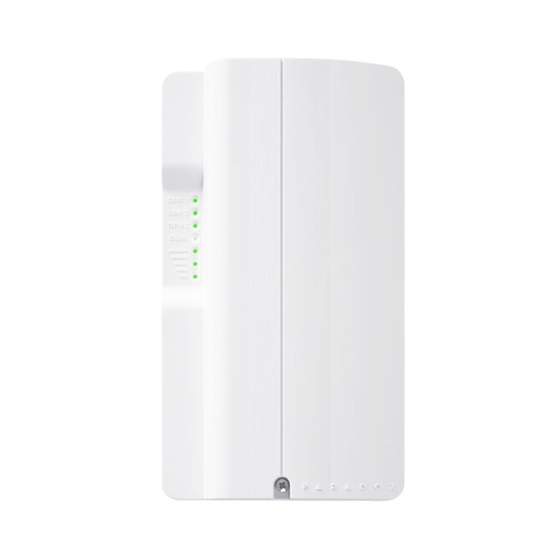Advertisement
Quick Links
PCS250G
GPRS/GSM Communicator Module
Installation and Programming Guide
**Compatible with Insite GOLD
and SWAN Server**
Installation
1 Mounting holes
1
9
2 GPRS Module with dual SIM
card slots
2
3 InField upgrade connector
3
4 Power terminal
5 Captive screw
6 Tamper screw knockout hole
8
4
7 Serial cable connector
7
8 Tamper switch
9 Optional MMCX male
6
connector (for use antenna)
5
SIM Card Connection
The PCS250G supports two standard GSM provider SIM cards.
To install the SIM cards, open the SIM Card tray and insert card into slot,
as shown. SIM Card 1 is used as "Primary" and SIM Card 2 for "Backup".
Panel Connections
The PCS250G is connected directly from the serial cable connector
located on the bottom of the unit to the serial connector of the panel
using the provided serial cable.
GPRS (Serial Connector)
PCS250G
Serial cable up to 2m
Antenna Extension Connection
Use an antenna extension kit to improve RF reception if your module's
signal strength is weak. Antenna kits are purchased separately.
IP150 Connection
The PCS250G can be connected to the IP150 Internet Module's PCS port.
For more information on how to configure this option, please refer to the
IP150's Installation manual.
UC300 Connection
The PCS250G can be connected to the UC300 Serial port. For more
information on how to configure this option, please refer to the UC300's
Installation manual.
Powering-up the PCS250G
Once your hardware connections are completed, the PCS250G module
will begin its power up sequence.
• SIM1, SIM2, GPRS, and GSM LEDs will flash intermittently for several
seconds.
• SIM card 1 LED will slowly flash green while searching for the GSM
network; once found the LED will be solid green and signal strength
LEDs turn on (depending on network strength).
If configured for GPRS reporting, you will need to configure network
provider information. Refer to Programming.
LED Functionality
LED
Functionality
SIM1 and SIM2 Solid green - SIM Card 1/2 is installed on the GPRS
module
Quick green flashing - SIM card 1/2 is exchanging data
Slow green flashing - Searching the network
Flash red (once) SIM Card 1/2 is defective
Off - SIM Card 1/2 is not installed, not active, or
currently not in use
GPRS
Solid green - unit is set for GPRS operation
Quick green flashing - exchanging data
(when this LED in ON, the GSM LED stays OFF)
GSM
Option not applicable on the PCS250G
Signal
Three LEDs indicate network strength
Strength
Programming
In order to configure the PCS250G for reporting, you will need to first
configure your SIM cards. Please note that SIM Card 1 can be configured
via panel programming and SIM Card 2 via SMS.
GPRS Reporting (Serial Port Connection)
Network Provider Information
MG/SP
EVO
Feature
[921]
[2960]
APN part 1 (characters 1-16)
[922]
[2961]
APN part 2 (characters 17-32)
[923]
[2962]
APN user name part 1 (1-16)
[924]
[2963]
APN user name part 2 (17-32)
[925]
[2964]
APN password part 1 (1-16)
[926]
[2965]
APN password part 2 (17-32)
Important: This information can be obtained from your mobile network
provider.
Network Provider Information via SMS
Command
Description
P[password].APN2.NAME.
Used to program the SIM Card 2 Access
[Access Point Name]
Point Name
P[password].APN2.USER.
Used to program the SIM Card 2 Access
[Access Point Name]
Point User
P[password].APN2.PSW.
Used to program the SIM Card 2 Access
[Access Point Name]
Point Password
P[password].APN2.CLEAR Used to clear the SIM Card 2 Access Point
Name
P[password].VAPN2.
Used to view the SIM Card 2 Access Point
[CALL BACK PHONE
Name information
NUMBER]
GPRS Reporting Options
MG/SP
EVO
Feature
[918]
[2976] to
Account / Partition
[919]
[2983]
Registration
[806]
[2975]
[7] Off + [8] Off = landline only
[7] Off + [8] On = GPRS primary / landline
backup (default)
[7] On + [8] Off = landline only
[7] On + [8] On = landline and GPRS in parallel
Receiver Settings MG/SP
Receiver #:
1
2
IP address*
[929]
[936]
IP port **
[930]
[937]
IP address WAN 2
[931]
[938]
IP port WAN2
[932]
[939]
Receiver password
[933]
[940]
Security Profile
[934]
[941]
Module registra-
[935]
[942]
tion - Press [ARM]
to register
Receiver Settings EVO
Receiver #:
1
2
IP address*
IP port **
IP address WAN 2
[2984]
[2986]
IP port WAN2
Receiver password
Security Profile
* For 1 or 2 digit numbers, add "0's" before the digit: e.g.,
138.002.043.006
** Default = 10000
Enter [MEM] for blank space
Details
MG/SP: Sections
represent account/
partition 1 and 2
EVO: Sections
represent account /
partition 1 to 8
Backup
[943]
[944]
[945]
[946]
[947]
[948]
[949]
3
4
[2988]
[2990]
PCS250G-EI07 05/2018
Advertisement

Summary of Contents for Paradox PCS250G
- Page 1 [949] tion - Press [ARM] Programming to register In order to configure the PCS250G for reporting, you will need to first Receiver Settings EVO configure your SIM cards. Please note that SIM Card 1 can be configured Receiver #: via panel programming and SIM Card 2 via SMS.
-
Page 2: Technical Specifications
Used to program the SIM card 2 APN Patents Point Name] Password Your use of the Paradox product signifies your acceptance of these terms and conditions. The following US patents may apply 5,886,632 and 6,215,399. Other P[password].APN2.CLEAR Used to clear the SIM card 2 APN Canadian and international patents may apply.

















Need help?
Do you have a question about the PCS250G and is the answer not in the manual?
Questions and answers